- Token Terminal
- Posts
- Navigating the Crypto Frontier with Bitwise
Navigating the Crypto Frontier with Bitwise
Our recent conversation with Ryan Rasmussen, Senior Researcher at Bitwise, covers Bitwise's product offering, approach to investor education and investment, as well as some predictions for the rest of the year.

Bitwise Asset Management has established itself as a trusted advisor for traditional investors that look to enter the crypto asset space. Our recent conversation with Ryan Rasmussen, Senior Researcher at Bitwise, covers Bitwise's product offering, approach to investor education and investment, as well as some predictions for the rest of the year.
Watch the full interview with Ryan:
The below article is a summary of our discussion with Ryan. Note that the text has been edited for clarity.
What is Bitwise?
Bitwise is among the leading crypto index fund managers in the world. Founded in 2017, Bitwise has positioned itself as the bridge between crypto and traditional financial advisors, RIAs, hedge funds, pension funds, and more.
Bitwise offers a suite of investment products, ranging from index funds and single-asset funds to crypto equities funds – all designed to provide investors with passive exposure to the crypto market.
Bitwise recently launched their Bitcoin ETF, which has accumulated more than $2 billion in assets to date.
Which Assets Does Bitwise Consider “Investment Grade”?
The majority of Bitwise's funds follow a passive investment strategy. The funds track the top crypto assets by sector, and rebalance either monthly or quarterly based on predefined criteria, such as market cap, liquidity, security, and regulatory developments.
The firm has adopted a conservative investment approach to minimize risks and protect investor capital. The goal is to build trust with investors and prioritize long-term relationships through careful risk management, even at the cost of missing out on rapid gains during bull markets.
It's important to be conservative, even though that might hurt a little bit in bull markets, it hurts far less in bear markets.
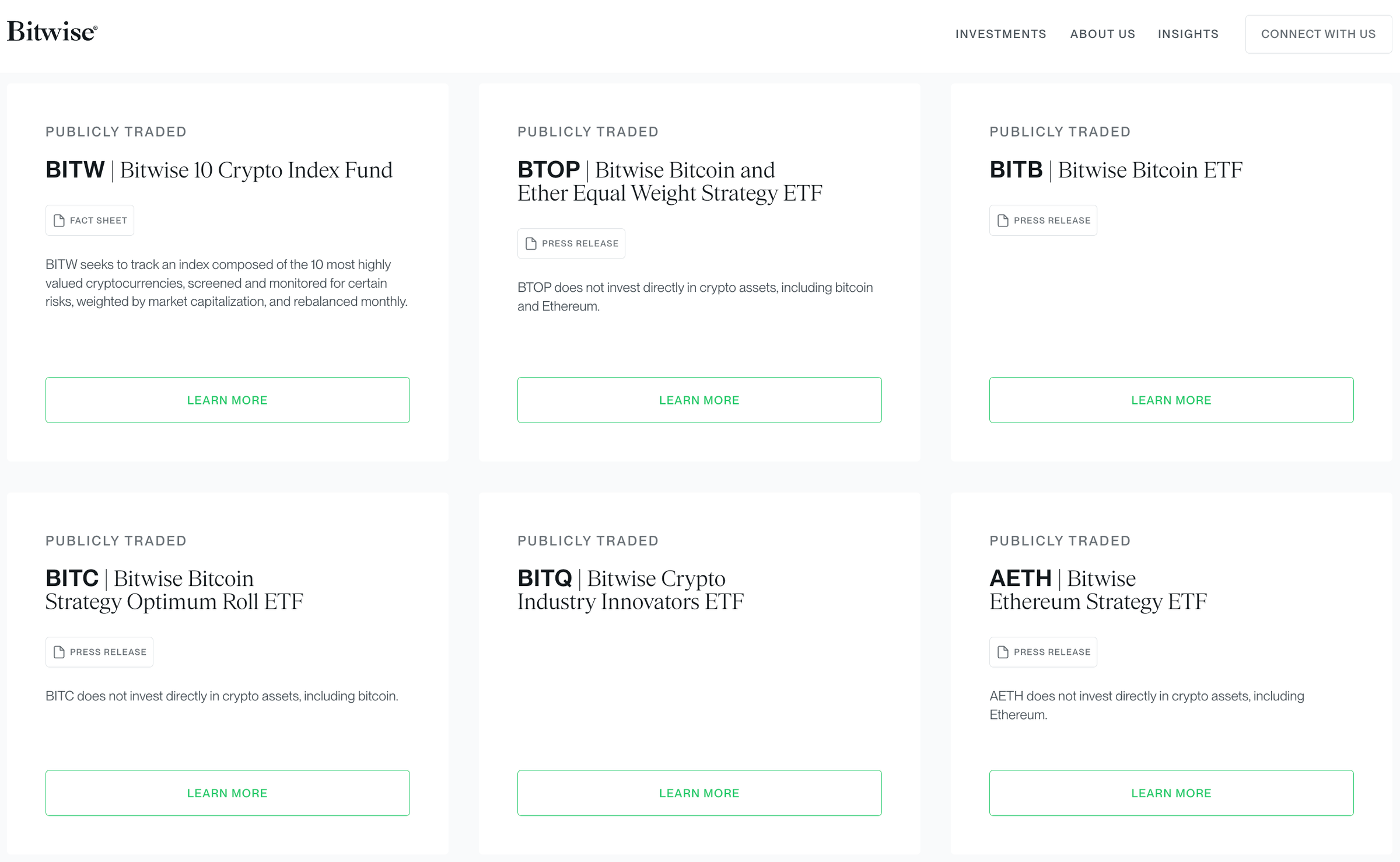
An overview of some of Bitwise's investment products.
The Current State of Institutional Interest Towards Crypto
There's been a noticeable uptick in institutional interest towards crypto, with more financial advisors and institutions recognizing its potential as a legitimate asset class.
In general, institutional clients tend to allocate only a small portion of their overall portfolio to crypto. The allocation for crypto is often between 1-5%. Bitwise dedicates significant effort to assist investors, particularly those with limited time for crypto, by filtering through the market to identify long-term viable crypto assets.
Most “TradFi” investors still focus only on Bitcoin. However, once an investor has exposure to Bitcoin, they tend to become interested to explore the space further. Recently, there's been significant interest towards Ethereum and Solana. While most discussions tend to revolve around the top 3-5 crypto assets, occasionally, investors ask about NFTs, DeFi, or meme coins, which shows that investor curiosity continues to expand beyond just the biggest names in crypto.
How Financial Advisors Operate, and How It Affects Crypto Allocations
The introduction of Bitcoin ETFs has significantly changed how financial advisors add crypto to client portfolios. Before, the complexities surrounding custody and compliance made advisors wary. Now, with ETFs, most of these hurdles have been abstracted away.
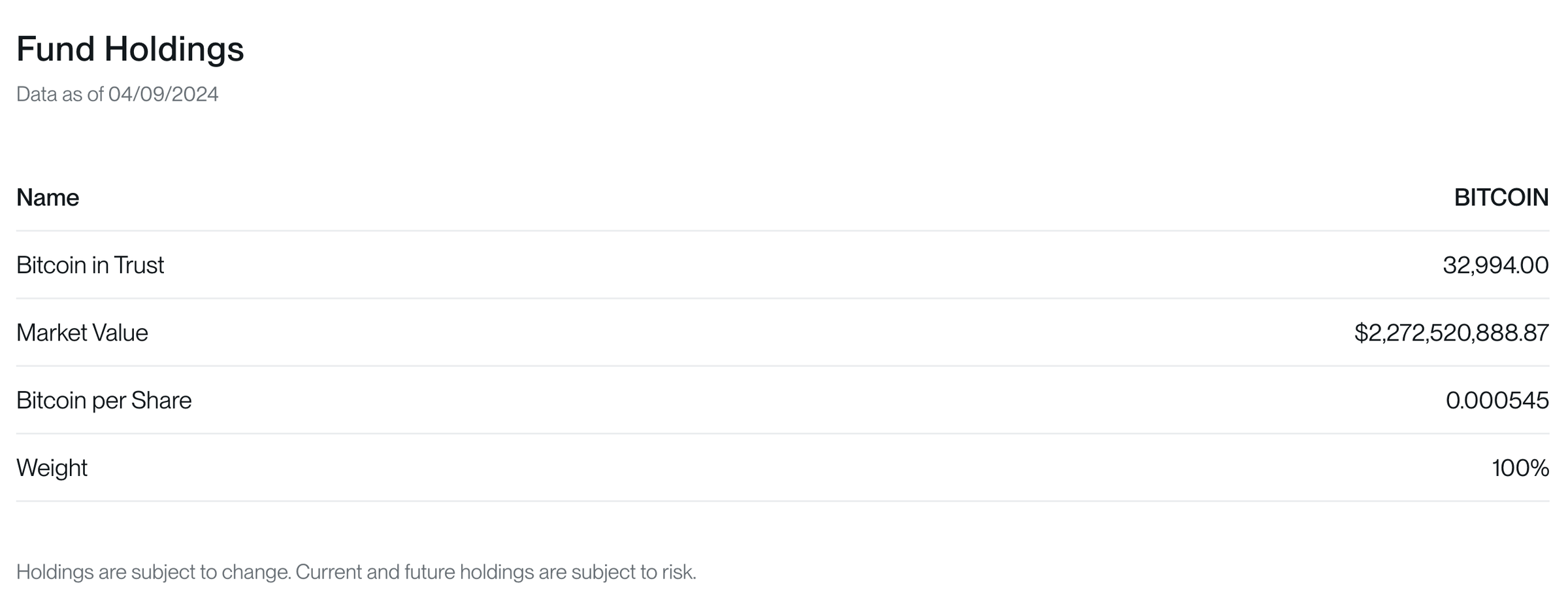
BITB fund holdings as of 09/04/2024.
The main goal for financial advisors is to grow their client base and “assets under advisory”. Most clients are used to traditional equity market gains, not the high returns that we're used to seeing in the crypto market.
Most financial advisors approach crypto with the knowledge that they might lose their entire investment. As a result, many advisors recommend their clients to invest 1-3% in crypto, since even in the worst case scenario, the overall portfolio would still be recoverable, and more comparable to a volatile period on the stock market.
The Differences Between BTC and ETH from an Investment PoV
Bitwise approaches Bitcoin and Ethereum from a portfolio construction point-of-view:
Bitcoin serves as a digital gold, and provides an inflation hedge..
Ethereum represents a technology investment in a platform that powers future crypto applications.
This differentiation helps investors understand the unique value proposition and associated risk with both assets.
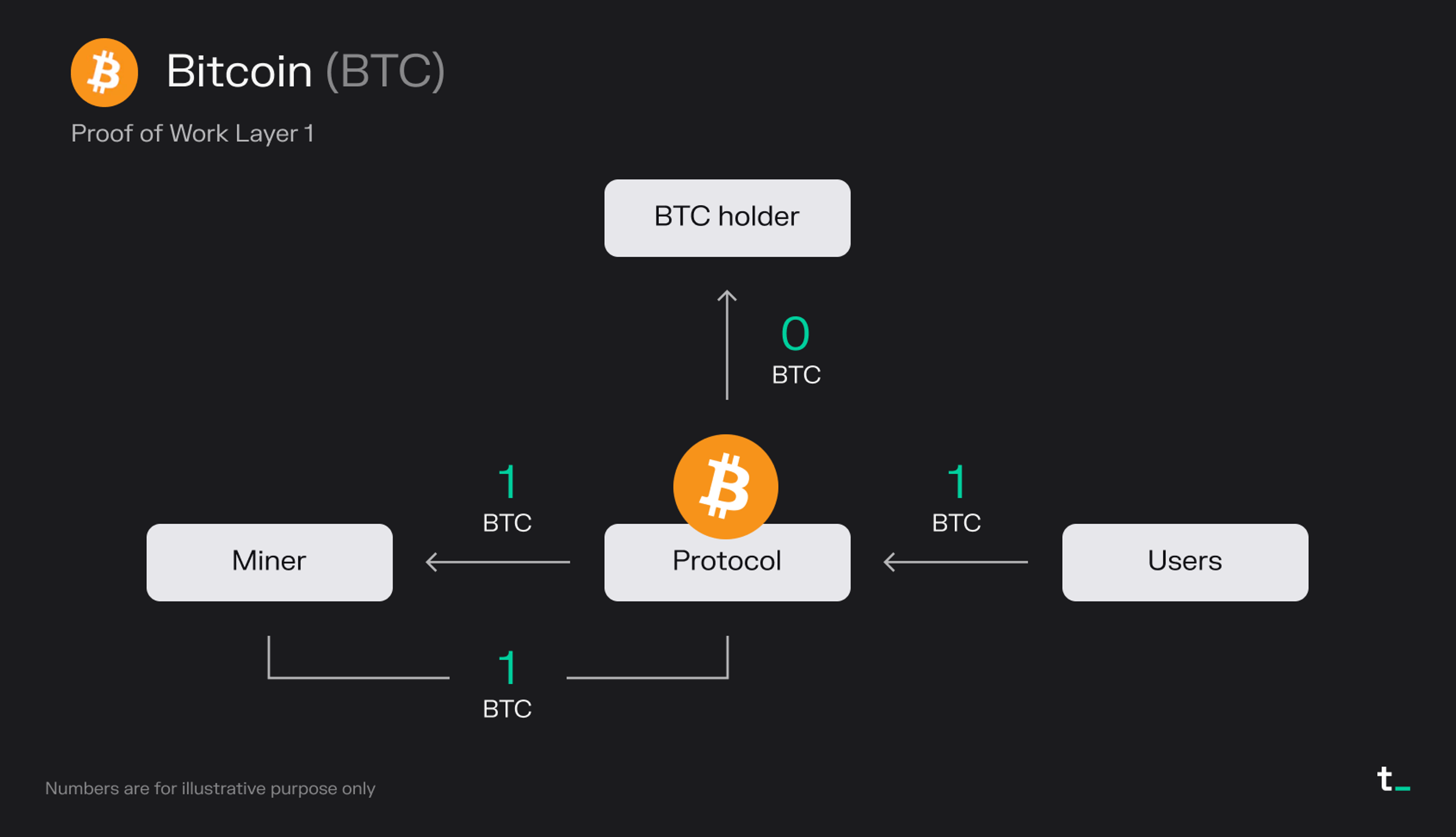
Bitcoin's economic model.
What happens above?
Users pay 1 BTC in transaction fees for a block
Miner receives all the fees (1 BTC)
Miner earns 1 BTC from the block rewards (newly issued BTC)
End result:
Miner receives 2 BTC
Bitcoin serves as an inflation hedge in an investor’s portfolio. This pitch is relatively easy for investors to grasp, due to Bitcoin's capped supply and continuously increasing scarcity (halvings) on the one hand, and increasing demand through ETFs on the other hand. Bitcoin is well-positioned as an alternative to traditional store-of-value investments.
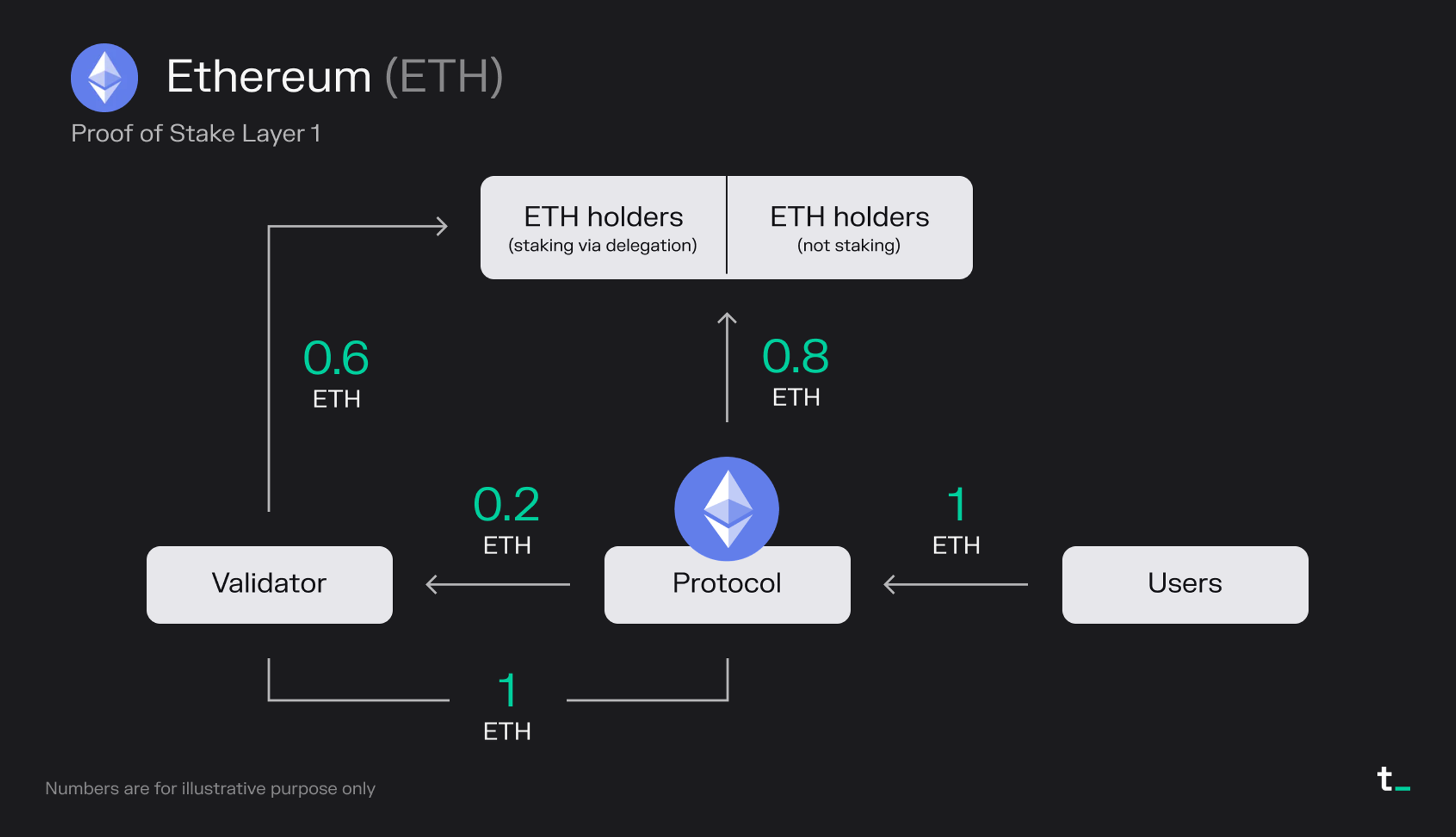
Ethereum's economic model.
What happens above?
Users pay 1 ETH in transaction fees (incl. MEV) for a block
0.8 ETH gets burned —> “share buyback” that benefits all ETH holders equally
Validator earns 0.2 ETH from the fees
Validator earns 1 ETH from the block rewards (newly issued ETH)
Since the validator has received half its stake from delegators, the validator has to share 50% of its revenue with those ETH holders
End result:
0.8 ETH is burned
Validator receives 0.6 ETH
ETH holders that staked via delegation receive 0.6 ETH
Ethereum fits into the technology/venture part of an investor’s portfolio. The same line of reasoning applies to other smart contract platforms, such as Solana. After all, their primary business model is to serve as the platform for other crypto applications.
Ethereum's fee burn mechanism is often called a “programmatic dividend”. This type of talk has the potential to make ETH the asset increasingly appealing also to more traditional value investors.
Thoughts on a Potential Ethereum ETF
Ryan believes that as of today, an Ethereum ETF might not get as much attention from investors as the Bitcoin ETFs have received.
Even if he’s optimistic about the future of crypto assets and eager to see investors access these assets earlier, the reality is that most investors have not yet built up a necessary level of understanding of Ethereum in order to have long-term conviction in it.
Compared to Bitcoin, Ethereum introduces many new concepts, such as staking, MEV, fee burns, etc., which all add complexity for those new to the asset. If an Ethereum ETF were to launch soon, say by the next SEC decision deadline, it's unlikely that there would be sufficient investor readiness and interest for it.
Many investors and advisors are just starting to consider Bitcoin as an investment, and/or have yet to receive internal approval for making the investment.
The expectation is that the demand for an Ethereum ETF grows significantly, once sufficient time has passed and Bitcoin has become a core component in institutional investor portfolios. Therefore, an ETF launch date that’s a year or two in the future, could be more favourable to Ethereum.
How does Bitwise Educate Investors and Advisors in Practice?
Bitwise educates investors through easily accessible content, webinars, and direct outreach.
The content includes memos by their Chief Investment Officer, Matt Hougan, and thematic presentations on Bitcoin, Ethereum, and other key crypto concepts, prepared by the company’s research team.
Further, a sales team of ~25 people frequently travels across the country to organize educational sessions with financial advisors and investors. The goal of these events is to address key concepts and topical themes in the market.
Bitwise also collaborates with external platforms that focus on ongoing education of financial advisors and institutional investors. In many instances, they need to earn ongoing education credits to maintain their professional licenses. In practice, Bitwise hosts webinars through these platforms and allows attendees to earn the required credits. This way, Bitwise is able to meet its customers where they are.
The Role of Onchain Data in Investor Education
Bitwise prefers to leverage onchain data in a standardized and TradFi-friendly format, since that’s what their customer base is already accustomed to.
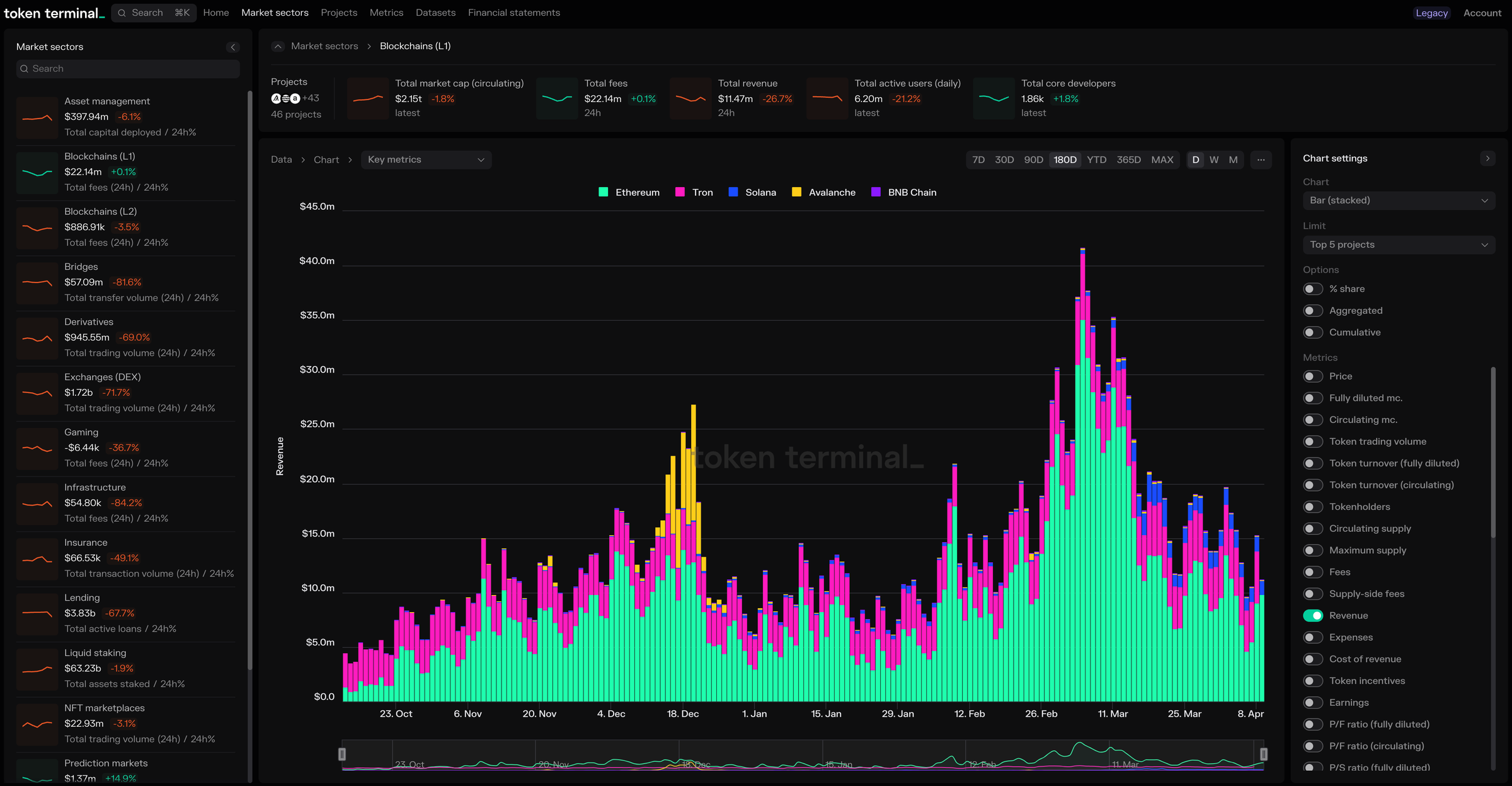
Revenue for the top 5 projects in the Blockchains (L1) market sector over the past 180 days.
Bitwise uses Token Terminal to gather market sector-level data, with a key focus on metrics like revenue and monthly active users (MAU). The team compiles the data into reports that are shared to the company’s stakeholders.
Bitwise produces a quarterly crypto market review, which they’ve modeled after JPMorgan Guide to the Markets-report. The goal is to offer investors a holistic view into the crypto market. The reports tend to include information about the performance of the company’s investment products, crypto asset & crypto equities fundamentals by market sector, and more.
The presented metrics are usually selected based on their relevance to advisors. For instance, traditional investors might not be familiar with terms like Total Value Locked (TVL), whereas they do recognize terms like net deposits, capital deployed, or assets under management, which convey the same information in a more easy-to-understand manner.
Token Terminal does a great job of translating crypto data into traditional metrics.
Current Crypto Use Cases that Ryan Finds Most Interesting
A question that Ryan gets frequently from investors and financial advisors has to do with the practical applications of crypto. Are crypto assets purely speculative, or do they offer real-world utility? To address the investor skepticism (or curiosity), Bitwise publishes an annual paper that highlights impactful use cases of crypto – practical applications that go beyond investment-as-a-use-case.
As examples, Ryan points out decentralized social media, tokenized real-world assets, and prediction markets as the new interesting frontiers that drive crypto adoption. You can read more about these use cases from the Bitwise report: 12 Real-World Stories of How Millions of People Are Using Crypto Services Today.